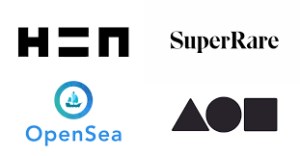non-fungible tokens
NFTs are currently taking the digital art and collectibles world by storm. Digital artists are seeing their lives change thanks to huge sales to a new crypto-audience.
What are NFTs?
Non-fungible tokens or NFTs are cryptographic assets on a blockchain with unique identification codes and metadata that distinguish them from each other.
Unlike cryptocurrencies, they cannot be traded or exchanged at equivalency. This differs from fungible tokens like cryptocurrencies, which are identical to each other and, therefore, can be used as a medium for commercial transactions.
The distinct construction of each NFT has the potential for several use cases. For example, they are an ideal vehicle to digitally represent physical assets like real estate and artwork.
Because they are based on blockchains, NFTs can also be used to remove intermediaries and connect artists with audiences or for identity management.
NFTs can remove intermediaries, simplify transactions, and create new markets.
In February 2021, a 10-second video by an artist named Beeple sold online for $6.6 million.

source: google/images.com
Non-fungible tokens (NFT)
- A way to represent anything unique as an Ethereum-based asset.
- NFTs are giving more power to content creators than ever before.
- Powered by smart contracts on the Ethereum blockchain

source: google/images.com
What does “non-fungible” mean?
- Every bitcoin is worth as much as every other bitcoin. NFTs, on the other hand, are all unique.
- “Fungibility” refers to goods or assets that are all the same and can be swapped interchangeably.
- A dollar bill is another perfect example — each is worth exactly one dollar.
source: youtu.be/Xdkkux6OxfM
What are NFTs used for?
<> NFTs and Ethereum solve some of the problems that exist in the internet today. As everything becomes more digital, there’s a need to replicate the properties of physical items like scarcity, uniqueness, and proof of ownership.
<> Not to mention that digital items often only work in the context of their product.
<> For example you can’t re-sell an iTunes mp3 you’ve purchased, or you can’t exchange one company’s loyalty points for another platform’s credit even if there’s a market for it.
 .
. 
source: google/images.com
<> Here are some examples of NFTs that exist today, to help you get the idea:
How do NFTs work?
NFTs give the ability to assign or claim ownership of any unique piece of digital data, trackable by using Ethereum’s blockchain as a public ledger.
An NFT is minted from digital objects as a representation of digital or non-digital assets.
For example, an NFT could represent:
- Digital Art:
- GIFs
- Collectibles
- Music
- Videos

source: google/images.com
In other words, if you own an NFT:
- You can easily prove you own it.
-
- Proving you own an NFT is very similar to proving you have ETH in your account.
- For example, let’s say you purchase an NFT, and the ownership of the unique token is transferred to your wallet via your public address.
- The token proves that your copy of the digital file is the original.
- Your private key is proof-of-ownership of the original.

source: google/images.com
NFT’s have some special properties:
- Each token minted has a unique identifier that is directly linked to one Ethereum address.
- They’re not directly interchangeable with other tokens 1:1. For example 1 ETH is exactly the same as another ETH. This isn’t the case with NFTs.
- Each token has an owner and this information is easily verifiable.
- They live on Ethereum and can be bought and sold on any Ethereum-based NFT market.

source: google/images.com
Where do you buy or sell NFTs?
- Opensea, a peer-to-peer marketplace that will make minting, purchasing, showcasing, and discovering NFTs easier than ever, is coming soon.
- If you’re more interested in games and sports collectibles, developers like Dapper Labs have created experiences including NBA Top Shot (virtual trading cards) and Cryptokitties (a Pokemon-ish digital-cat collecting app that actually was the first NFT hit in late-2017).
-
Online games including Gods Unchained are starting to use NFTs to sell in-game assets like weapons or cosmetic upgrades. Real estate in new virtual worlds is sold via markets including Decentraland and The Sandbox.
- Some people display their digital artworks on large monitors. Some buy virtual real estate (via NFT, of course) in which they’re able to build virtual galleries or museums.
- You can also roam virtual worlds like Decentraland and check out other people’s collections. For some fans, the appeal is in the buying and selling — much like any other asset class.


